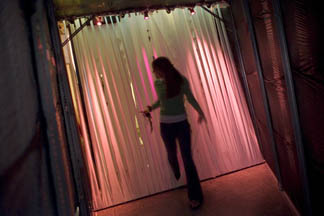Borrowing from tea house technique, design class exhibit alters small spaces

In a sophomore design studio class (DEA 201), students interpreted techniques from a traditional 15th-century Japanese method, Rites of Passage, that creates new spaces by "slowing time down" through obstruction of movement.
"In other words, you enlarge small spaces experientially, such as the Japanese did with elongated passages to Shinto tea houses," explained Jan Jennings, professor of design and environmental analysis and the instructor of the course.
On Nov. 30, the 20 students in the course presented an exhibition of their interior design installation based on the techniques.
"In their full-scale designs, the students used materials innovatively to configure pathways from outside the room to the inside," explained Jennings. "For example, students executed the 'mouse-hole' technique using bands of Lycra, in which visitors had to bend down slightly to enter, emulating the crawl space in Japanese tea houses. The designs called attention to a body's movement through space and included a space tunnel, darkened with walls of Flex-force trash bags; a zig-zag turn, with recycled cardboard walls; alternating physical constraints; an interlude, defined by a low-hanging polyurethane tarp; borrowed scenery and framed views. Visitors left the room through a hidden door and by another pathway different from the one they had entered.
"This was an amazing project, the best in my 13 years of teaching at Cornell," Jennings concluded.
Media Contact
Get Cornell news delivered right to your inbox.
Subscribe